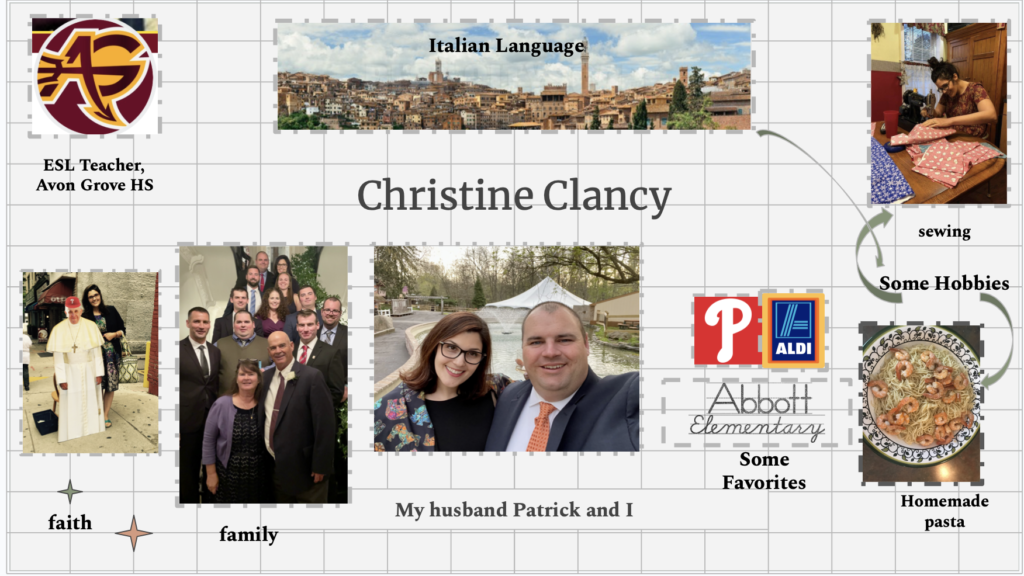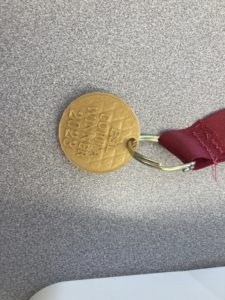Instructional Technology Projects
The following are projects from Educational Technology 500, a course at West Chester University
Google Slides
The “What?”

The purpose of an All About Me project is for educators and students to introduce themselves to one another and share about their identity. This project can be created on a platform such as Google Slides. It is a great task for the first couple of weeks of school when building a sense of classroom community is vitally important. Google Slides is a familiar tech tool for students, which is important for a few reasons. First, students feel more motivated at the beginning of the year to take risks, when projects seem “doable.” There is a fine line between engaging a learner in a task that stretches their thinking and one that is overly daunting. Google Slides is approachable and relatively simple to learn. Additionally, many of my students have interrupted formal education which often means their exposure to technology is limited. In setting the stage for these learners, especially in the beginning of the year, Google Slides is a valuable tool.
So What?
This assignment is a reflection of the following ISTE Standard:
Standard 2.2 Leader Educators seek opportunities for leadership to support student empowerment and success and to improve teaching and learning.
Educators:
2.2b Advocate for Equitable access to educational technology, digital content and learning opportunities to meet the diverse needs of all students
The All About Me poster is an equitable task because it relies more heavily on images than text. Since my students are learning English, this is a good way for them to feel included in the learning experience. They can feel empowered to share about themselves and their identity.
Now What?
I want to use the All about Me project within the first 2 weeks of school as a way to:
- Get to know my learners
- Allow them to introduce themselves to me and their classmates
- Share their identity
- Use technology in a creative way
Now that I have my own All About Me, I can model this task for my students. Admittedly, I will probably have students create a paper version of an “All About Me,” page before they jump into the Chromebook for several reasons. First, the act of building a classroom community should be ongoing, and not a singular project or task. Giving them several class periods to share about themselves is important. Also, my students will likely earn a “quick win,” and feel more confident by first completing this task on paper. Finally, I want this task to take some quality time and not be something they rush through just to “get it done.” My hope is they can work on this task while I am able to conference with learners and give students feedback on their work. Eventually I will have the students give feedback on each others’ work through a checklist or rubric.
![]()
![]()
3D Printing Projects
 If there is one activity my students look forward to every year, it is the annual ESL Copita. This mini round-robin soccer tournament takes place over 2 days and consists of student-led teams squaring off against a teacher team. The Copita is mainly open to high school students in the English Language Development program but other students also join occasionally. In the weeks leading up to the tournament, I hear students plotting and planning who will be on their team and what color they will choose.
If there is one activity my students look forward to every year, it is the annual ESL Copita. This mini round-robin soccer tournament takes place over 2 days and consists of student-led teams squaring off against a teacher team. The Copita is mainly open to high school students in the English Language Development program but other students also join occasionally. In the weeks leading up to the tournament, I hear students plotting and planning who will be on their team and what color they will choose.
Last year the winning team received certificates but that wasn’t exciting enough for our young soccer stars. They wanted medals! We scoured the internet and Dollar Store in search of plastic medals that are sometimes sold during an Olympic year. Instead the CAD class was able to make medals using the 3D Printer!
![]()
So What?
This project was a collaborative effort and that is reflected in the ISTE standard below:
2.4 Collaborator
Educators dedicate time to collaborate with both colleagues and students to improve practice, discover and share resources and ideas and solve problems. Educators:
2.4a Dedicate planning time to collaborate with colleagues to create authentic learning experiences that leverage technology
The 3D printed medals were truly a collaborative effort among teachers in various departments and students. In previous years the ELD team didn’t consider using other resources in the building when printing certificates for the winning soccer team The ELD Department worked with the Technology department to plan the Copita medals. Additionally, students who are both in the ELD program and the CAD classes who make 3D projects were able to earn a grade for that class. Everyone who participates in the Copita is enjoying a shared vision for making school fun and engaging for ELs.
Now What?
There are many ways to extend the 3D printing project beyond this year. Students could participate in a contest to design each year’s medal. They can also visit the CAD classroom and see the 3D printing in action. Many of the newly arrived English learners also have a SLIFE (Students with limited or interrupted formal education) designation. Research suggests that these learners in particular benefit from concrete and hands-on tasks to serve as a bridge before moving into literacy based projects. Designing, watching and even participating in the medals being made would be a tremendous task-based writing activity. Students could use transition words (first, next, then, etc…) to record the steps in the process of making 3D medals.
Garageband
Music has always been a big part of my life. I played clarinet from 4th grade into adulthood and even studied privately with a music professor at Millersville University, where I have wonderful memories of playing in the wind ensemble. I still remember being in high school and learning that a piece of music we were playing was meant to represent France during World War II. My adolescent brain had never conceived that an instrumental music piece, seemingly abstract, could represent a concrete time in history. Garageband is similar. Students can compose music that is meant to evoke a particular genre of literature, theme or mood in a story.
See Sample below:
So What?
ISTE calls for students to be designers. In the standard below, students are tasked with engaging in authentic tasks that compel them to think more deeply about the content.
2.5 Designer
Educators design authentic, learner-driven activities and environments that recognize and accommodate learner variability. Educators:
2.5.b
Design authentic learning activities that align with content area standards and use digital tools and resources to maximize active, deep learning.
Garageband is a great tool to accompany a podcasting project. I currently co-teach an 11th grade English language arts class with advanced English learners. The students are assigned a project to create an investigative journalism podcast modeled after Serial. Giving students the ability to create a song to introduce their podcast could be a great way for them to share the overall mood of their show. The benefit of podcasting, especially for English learners, is that it fosters oral language development. Knowing the tone that they want to convey in their podcast is important and music can add to that. Also, music is a universal language, making it a good entry point for English learners to engage in the lesson.
Now What?
It took more time than I expected to create a short piece in Garageband. I imagine high school students could experience similar challenges. Garageband could be a good independent learning station or extension activity while students complete their podcasts. In order for this task to align with ELA or ELD standards, students would need to be ready to explain their musical choices and the mood they are trying to convey. This would demonstrate their ability to engage in disciplinary conversations.